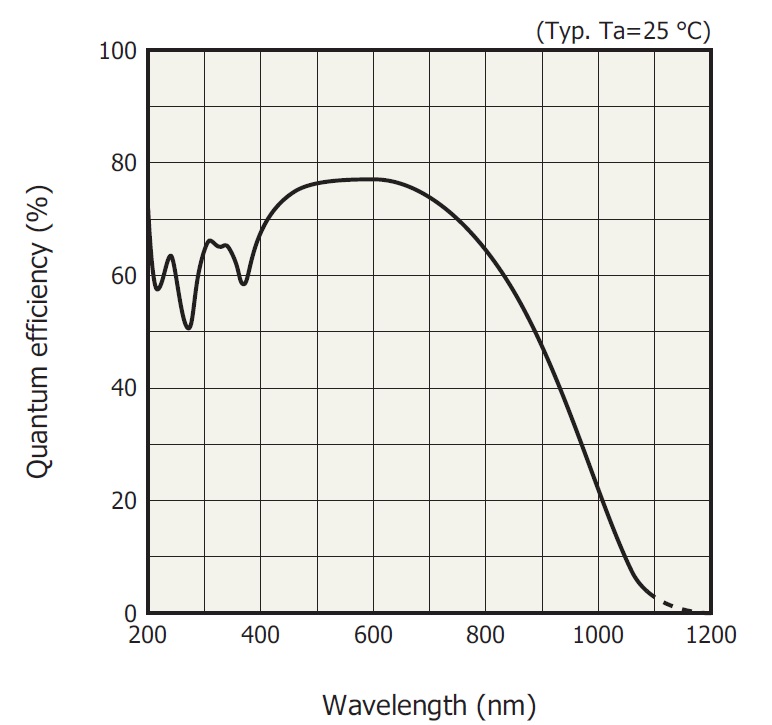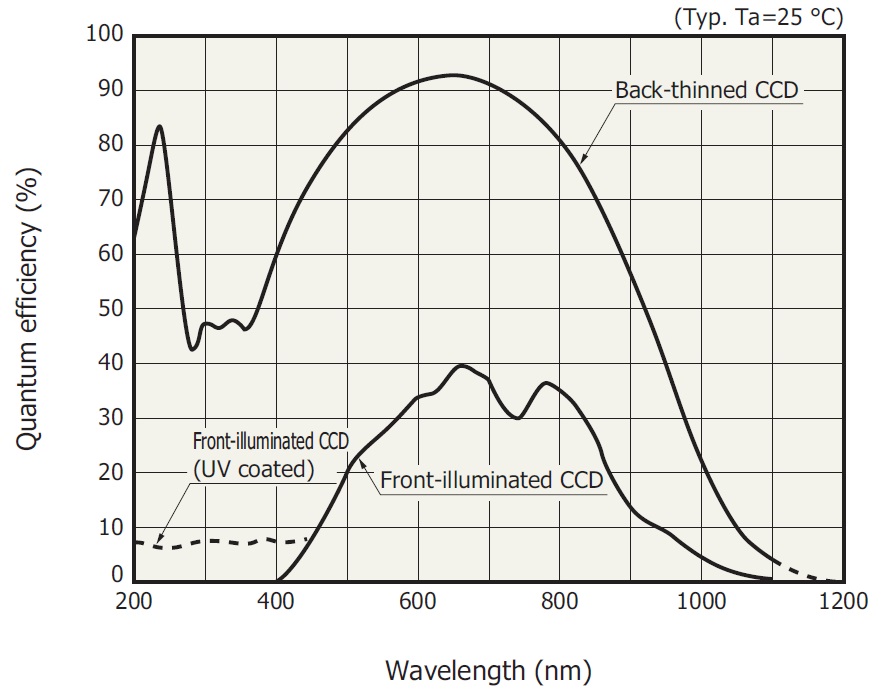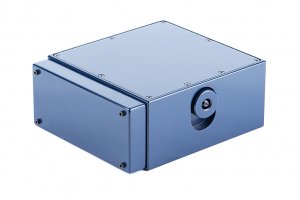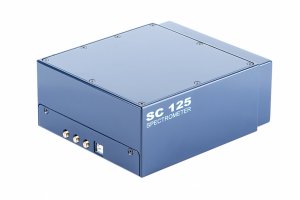Model SC125
FEATURES
The compact high-sensitivity spectrometer SC125 is developed for low light applications such as measurements of Raman scattering, fluorescence, etc., which require especially high sensitivity or enhanced specifications in the UV spectral range.
UP-TO-DATE MODEL BASED ON BACK-THINNED ARRAYS FOR OPERATION WITH LOW SIGNALS
ENHANCED UV SENSITIVITY
MONOLITHIC HOUSING FOR OPTIMUM STABILITY
INTERNAL LIGHT TRAPS TO REDUCE STRAY LIGHT
FLEXIBLE CONFIGURATION, INCLUDING A CHOICE OF DIFFRACTION GRATINGS, SPECTRAL RANGES AND RESOLUTIONS TAILORED TO YOUR REQUIREMENT
USER-FRIENDLY INTERFACE COMPATIBLE WITH WINDOWS XP, WINDOWS 7, 32/64 BITS
DESCRIPTION
The high-aperture optical bench of the SC125 has no moving parts and minimises the number of reflective surfaces. The SC125 features a monolithic housing, thus ensuring long-time measurement stability. The case has internal fins – light traps which allow reducing stray light which is a typical problem of compact short-focal length instruments.
The SC125 may contain as a detector either one of two non-cooled Hamamatsu back-thinned CCD-arrays without a charge-storage section (back-thinned FFT CCD), operating in the binning mode. Both arrays have wide spectral range and excellent sensitivity in the UV (see below for the curves of each detector spectral sensitivity and their specifications). These two arrays differ in quantum efficiency, data reading rate, dynamic range, and in pixel active area size.
.
The detector based on the S7030-1006 CCD-array is more sensitive, has lower noise, better values of dynamic range and uniformity. The detector based on the S10420-1106 CCD array is faster, has anti-blooming and, since it has a greater number of pixels and smaller pixel size, ensures better spectral resolution than the S7030-1006. The IMAGING Version (Optional) features an astigmatism compensator – cylindrical lens – installed after the entrance slit. This further enhances of system sensitivity.
Spectral curve of sensitivity of the back-thinned CCD detector model S10420-1106
Spectral curve of sensitivity of the back-thinned FFT-CCD detector model S7030-1006 in comparison with front-illuminated CCD with and without UV-coating
SPECIFICATIONS
| SPECTROMETER MODEL | SC125- S10420 | SC125- S7030 |
| Spectral range, nm | 200-1100 | |
| Focal length, mm | 125 | |
| F/number | 1 : 3.9 | |
| Entrance slit (one to choose) | fixed width: 14µm, 30µm and 50µm | |
| Spectral resolution | depends on selected diffraction grating (see table below) | |
| CCD-detector model | S10420-1106 | S7030-1006 |
| Number of pixels | 2068 x 70 | 1024 x 64 |
| Number of active pixels | 2048 x 64 | 1024 x 58 |
| Pixel size, µm | 14 x 14 | 24 x 24 |
| Active area size, mm | 28.672 x 0.896 | 24.6 x 1.4 |
| Maximum spectral sensitivity, nm | 500 | 650 |
| Maximum quantum efficiency | >75 % | >90 % |
| Non-uniformity of sensitivity1) | ±10 % | ±3 % |
| Anti-blooming2) | yes | No |
| ADC | 16bit, 250 kHz | 16bit, 125 kHz |
| Mean-square reading noise, ADC counts | < 12 | < 7 |
| Dynamic range | ~ 8000 : 1 | ~15 000 : 1 |
| Exposure time | 8.3ms — 3s3) | 8.2ms — 2s3) |
| Frame processing time in the binning mode, ms | 9.39 | 9.12 |
| Thermoelectric cooling | no | |
| Operating temperature | 10- 30°C | |
| Computer interface | Full Speed USB | |
| Synchronisation | IN/OUT | |
| Optical input | Optical quartz fiber core dia 0.6mm (option 0.4mm), length 1m, SMA-905 connector | |
| Dimensions, mm | 158 × 182 × 74 | |
| Weight, kg | 2.2 | |
1) Signal level – 50% of saturation.
2) Anti-blooming – sensor’s feature eliminating overflow of charges from over-exposed pixels to the neighboring ones.
3)Maximum storage time is deemed to be the time at which dark signal reaches 10% of the dynamic range at the ambient temperature +25°C.
RECOMMENDATIONS FOR CHOOSING A DIFFRACTION GRATING
At the time of placing your order you should choose a grating lines density (i.e. spectral resolution of your instrument), as well as the spectral range for operation. For your convenience the table below lists the average values of grating dispersion, spectral resolution and multichannel array bandpass.
| DIFFRACTION GRATINGS, LINES/MM | 1800 | 1200 | 900 | 600 | 400 | 300 | 200 |
| — possible spectral range of grating operation, nm | 180-600 | 180-900 | 180-1100 | 180-1100 | 190-1100 | 200-1100 | 200-1100 |
| — multichannel array bandpass (average), nm1) | 1052)923) | 1702)1453) | 2302)2003) | 3502)3003) | 5402)4603) | 7202)6203) | 10002)9203) |
| — reciprocal linear dispersion (average), nm/mm1) | 3.8 | 6.0 | 8.2 | 12.5 | 19.0 | 25.4 | 38.0 |
| — spectral resolution (average), nm | 0.162)0.223) | 0.252)0.363) | 0.342)0.53) | 0.52)0.753) | 0.82)1.13) | 1.02)1.53) | 1.62)2.33) |
1) for 300nm wavelength.
2) for the SC125- S10420 model.
3) for the SC125- S7030 model.
EXAMPLE: If you are interested in the1200 lines/mm grating and the S10420-1106 detector (spectral resolution of 0.25nm), then you should choose the location of 170nm multichannel array bandpass within the possible 180-900nm spectral range of the grating. For instance, the SC125- S10420 spectrometer operating in the range of 250-420nm with 0.25nm resolution.
The values indicated in the table are calculated for 300nm wavelength. With increased wavelength, dispersion of a specific grating and multichannel array bandpass are slightly decreased and resolution is improved. Contact a SOLAR LS specialist for more precise calculation of parameters for your instrument.

Spectral curve of sensitivity of the back-thinned CCD detector model S10420-1106

Spectral curve of sensitivity of the back-thinned FFT-CCD detector model S7030-1006 in comparison with front-illuminated CCD with and without UV-coating
OPTIONS & ACCESSORIES
At your request the SC125 spectrometer can be equipped with optional calibration of spectral sensitivity.
SENSITIVITY CALIBRATION
Spectral ranges of calibration:
- Cal-UV: within 220-400nm.
- Cal-VIS: within 300-1050nm.
- Calibration is performed with certified light sources (a deuterium lamp for the 220-400nm spectral range and a halogen lamp for the 300-1050nm range). It is made using a fiber input and is valid for 1 year provided that the optical fiber is not removed from the spectrometer. Calibration accuracy is +/-10%.
WHAT POSSIBILITIES ARE OFFERED BY SPECTRAL SENSITIVITY CALIBRATION
Whereas in the past the spectrum of your light source was superimposed by spectral curves of diffraction grating efficiency, detector sensitivity, reflective index of mirrors, now you have the opportunity to restore true spectra of the analysed source. You will be able to:
- record true spectra
- mathematically decompose complex lines of the spectrum into its components*
- determine the tristimulus values and colour-rendering index of light sources*
- determine the light power density in the UV ranges A, B, and C*.
* Features marked with an asterisk are not included into the software of your spectrometer; they are implemented by exporting to external programs.
HOW CALIBRATION OF SPECTRAL SENSITIVITY RUNS
Spectra recorded by the SC125 spectrometers with TCD1304 Toshiba CCD detectors (14 bit) and S10420-1106 Hamamatsu CCD detectors (16 bit), and the reference spectrum of the deuterium lamp emission in the spectral range of 220-400nm are presented in Figure 1. The figure shows that, other things being equal, the S10420-1106 detector provides higher intensity than TCD1304 and the absence of intensity modulations, which can introduce additional distortions into sensitivity calibration. Besides, the S10420-1106 detector features a wider dynamic range (due to its low noise and through the use of 16 bit digitisation instead of 14 bit).
Fig. 1. True spectrum of the calibration lamp (black) and its spectra as recorded by the SC125 spectrometer with TCD1304 (blue) and S10420-1106 (red) detectors
Fig. 2. Calibration factor spectrum of the SC125-S10420 spectrometer
Figure 2 shows the spectral dependence of sensitivity calibration factor of the SC125-S10420 spectrometer in the range of 220-400nm. Increase of the calibration factor with decreasing wavelength is resulting from decrease of the detector sensitivity and reflective index of mirrors, along with the increase of photon energy. Multiplying the measured spectrum of your source by the spectrum of calibration factor (this is done automatically by the software) you will get the true undistorted spectrum.
Dependence of the signal acquired with the SC125-S10420 on intensity of the signal from the calibrated source (Figure 3) proves excellent linearity of the S10420 detector (as opposed to the TCD1304, which shows considerable nonlinearities at the edges of its dynamic range, i.e. at high and low signal levels). Good detector linearity provides a possibility to calibrate the spectrometer sensitivity for one exposure time, and then to use this calibration for other exposure intervals.
Fig. 3. Calibration factor of the SC125-S10420 spectral sensitivity vs exposure time
A detector based on the S7030-1006 Hamamatsu array has advantages similar to the S10420-1106 detector. Due to the above mentioned properties we recommend both of these detectors for use in spectral instruments with the sensitivity calibration option.
Prospects
Starting from mid-2014 we intend to perform sensitivity calibration of spectral instruments in the UV and visible spectral range with issuing certificates of calibration which will be recognised in the territory of CIS and Europe. Calibration will be made on the basis of an accredited calibration laboratory of the Institute of Physics of the Belarusian National Academy of Science with reference to national standards of Belarus, Russia and Germany. Calibration accuracy will depend on a chosen spectral range.
The emission will be input into a certified spectrometer via an optical integrating sphere (the scheme is shown in Figure 4), being the most proper approach in terms of minimising measurement errors. It should be noted however that sensitivity of the spectral instrument is greatly reduced (102-104 times).
Fig. 4. Scheme of the certified spectrometer with spectral sensitivity calibration
SOLARLS的所有資訊來自SOLARLS網頁,所有版權歸SOLARLS,繁體字版權屬安均科技。

